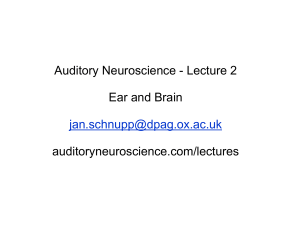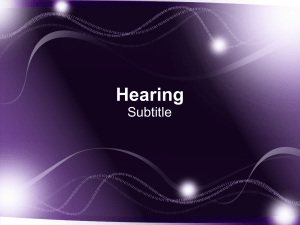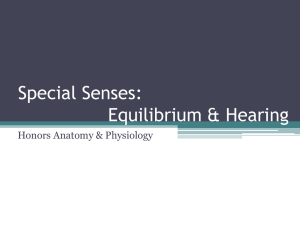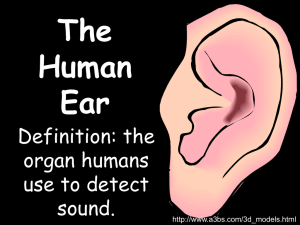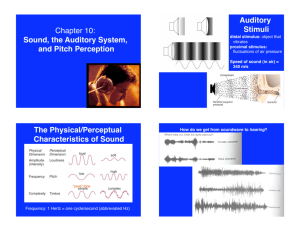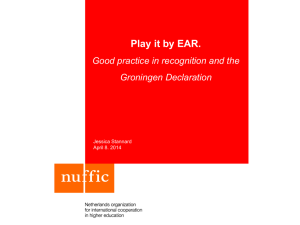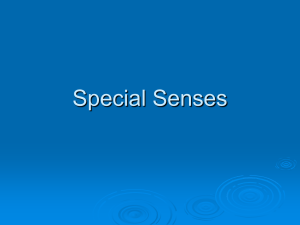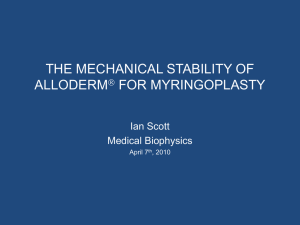Special Senses - Hearing
advertisement
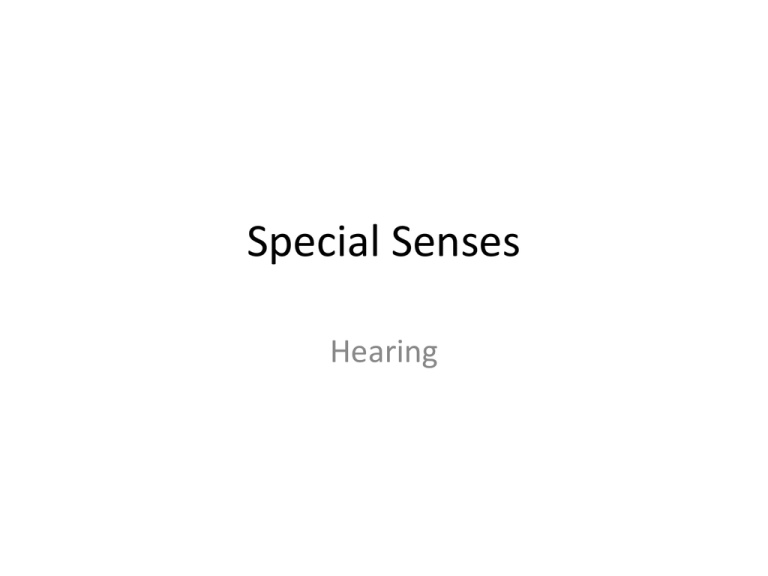
Special Senses Hearing Hearing • Ear is a very sensitive structure. – The sensory receptors convert vibrations 1,000 times faster than the photoreceptors of the eye can respond to light Structure • Three main regions – Outer Ear • Collects sounds waves and channels them inward – Middle Ear • Conveys the sound vibrations to the oval window – Inner Ear • Which houses the receptors for hearing and equillibrium Structure of the Ear Outer Ear • Consists of: – Auricle – External Auditory canal – Eardrum Auricle • Part of the ear you see • Structure: – Skin covered flap of elastic cartilage • Function: – Collect sound waves and direct them toward external auditory canl External Auditory Canal • Structure: – Two structures help keep out invaders • Few Hairs • Ceruminous gland – Secret cerumen (earwax) • Function: – Curved tube directs sound waves toward the eardrum Eardrum • A.k.a. Tympanic membrane • Structure: – Thin, semitransparent partition between external auditory canal and the middle ear • Function: – Changes sounds waves into vibrations Middle/Inner Ear Middle Ear • Small, air-filled cavity between eardrum and inner ear • Consists of – Auditory tube – Auditory ossicles Auditory Tube • Opening in the anterior wall of the middle ear leads to auditory tube (Eustachian tube) – Connects the middle ear to upper portion of throat – When it is open, air pressure equalizes on both sides of the eardrum • When closed – if air pressure builds the eardrum can rupture – Swallowing or yawing opens up the auditory tube Auditory Ossicles • 3 tiny bones span across the middle ear by means of ligaments – Malleus – Incus – Stapes • Forms a small opening, oval window, where the inner ear begins • Function – To pass the vibration from the outer ear to the inner ear Ossicles Inner Ear • Divisions – Bony Labyrinth • Series of cavities in the temporal bone, including the cochlea, vestibule, and semicircular canals • Contains a fluid called perilymph – Inner membranous labyrinth • Series of sacs and tubes with the general shape as the bony labyrinth • Contains a fluid called endolymph Bony Labyrinth • Cochlea – Sense organ for hearing • Semicircular canals and vestibule – Sense organs for balance and equilibrium Inner Ear Process of Hearing • Auricle directs sound waves to external auditory canal • External auditory canals continues to direct sounds waves to the eardrum • Eardrum converts sound waves into vibrations • Eardrum vibrates the malleus • Malleus vibrates the incus then to the stapes • Stapes move back and forth and pushing oval window in and out • Movement of oval window sets up the fluid pressure waves in the perilymph of the cochlea • Fluid pressure waves build and eventually cause the endolymph to transmit waves to the hairs inside the cochlea • Hairs are stimulated they release neurotransmitter molecules, change waves into electrical impulses • Electrical impulses to the brain through the auditory nerve
